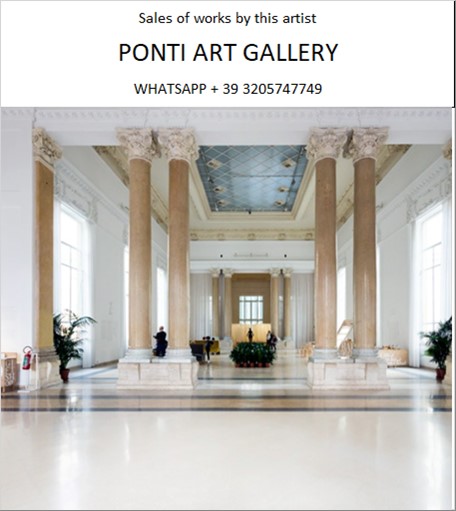Ponti Art Gallery is interested in buying and selling works
of art by this artist.

Prodosh Das-Gupta Biography
Prodosh Das Gupta, a luminary in the realm of Indian sculpture, was born in 1912 in Dhaka, which is now part of Bangladesh. His journey into the arts began after he graduated from Calcutta University in 1932. With a passion for sculpture, he pursued studies at the Lucknow School of Art and Crafts the same year. His quest for artistic mastery led him to the Government School of Art and Craft in Chennai from 1933 to 1937, where he trained under the tutelage of Devi Prasad Roy Chowdhury and earned his diploma in sculpture.
Das Gupta's dedication to his craft took him beyond the shores of India. He was awarded a fellowship by Calcutta University, which enabled him to travel to Europe and refine his skills at the Royal Academy of Arts in London and the Academie de la Grande Chaumiere in Paris between 1937 and 1939. This period was crucial in shaping his artistic vision as he honed his sculptural and bronze casting techniques.
The year 1943 marked a significant turn in Das Gupta's career when he, along with contemporaries Rathin Maitra and Subho Tagore, became a founding member of the Calcutta Group. This collective of artists emerged against the backdrop of the Bengal famine, a time of great social upheaval and suffering. The Calcutta Group sought to break free from the shackles of past traditions and engage with the global art scene. Their manifesto boldly stated that art should be international and inter-dependent, emphasizing the need for art to progress by embracing the rich and varied world of art created by masters across ages and geographies. The group's ethos was to place humanity at the center of their artistic expression, replacing the divine figures of the past with the human condition.
Das Gupta's sculptures from this era reflect the modernist movement in Indian art, which was consciously moving away from colonial and nationalist influences towards a more internationalist and independent identity. His work during this time was characterized by a search for a new language of artistic expression that resonated with the crises and anguish of the times.
In 1957, Das Gupta's career took another significant turn when he was appointed the curator of the newly established National Gallery of Modern Art (NGMA) in New Delhi. Over his thirteen-year tenure, he played a pivotal role in acquiring works by prominent artists such as M.F. Husain, F.N. Souza, Tyeb Mehta, Ram Kumar, and A. Ramachandran, thereby laying the foundation for the museum's permanent collection. His contributions helped establish the NGMA as a premier repository of modern Indian art.
Das Gupta's recognition extended beyond Indian borders. In 1955, he was made a Fellow of the Royal Society of Arts in London. His contributions to the field of art were further acknowledged when he was conferred the title of Fellow of the Lalit Kala Akademi in New Delhi in 1982.
Throughout his life, Das Gupta sought to find a sculptural form that could express contemporary ideas while preserving the inherent life-force, or prana, of traditional Indian sculpture. His works, which ranged from solid, symmetrical structures to irregular, fluid figures, were inspired by the fluid rhythm and gliding forms of masters such as Auguste Rodin, Constantin Brâncuși, Jean Arp, and Henry Moore. He was known for his "instant sculpture" technique, which involved creating sculptures in a matter of minutes, allowing him to engage with the material without preconceived notions.
Das Gupta's sculptures were not only a blend of Western influences and traditional Indian aesthetics but also an exploration of form and content. His artistic vision was progressive, and he believed that contemporary Indian sculpture needed to find its own roots and forms to express contemporary ideas and the energy they embody.
After his retirement from the NGMA in 1970, Das Gupta continued to be active in the art world. He was elected president of the Third International Association of Arts (UNESCO) Congress in Vienna in 1960 and served as an executive board member for three years. His travels took him to Czechoslovakia, Poland, and East Germany, where he engaged with artists and visited galleries and museums.
Das Gupta was also a poet, publishing a book of poems titled "Fallen Leaves" in 1969. His legacy continued to be celebrated posthumously with major retrospectives, including one at the NGMA in 2008. Prodosh Das Gupta passed away in 1991, leaving behind a rich legacy that continues to inspire and influence the world of Indian modern art.
Prodosh Das-Gupta Quotes and
Sales of Works
Ponti Art Gallery selects and deals with paintings by the
artist. Upon request, we provide free estimates and
evaluations, communicate prices, quotations, and current
market values.
If you are interested in BUYING or SELLING works by the
artist, contact us immediately.
If you wish to sell or receive an evaluation of the
works:
Send us a frontal photo of the painting, one of the back,
and one of the signature. Also, indicate the dimensions of
the work. Inform us about the purchase origin of the work
and any kind of available documentation (purchase
receipts, certificates of authenticity, publications). One
of our operators will respond to you on the same day. We
guarantee maximum confidentiality and extreme
professionalism.
If you wish to purchase works by the painter: Contact us
and let us know your request. We will inform you about the
available works. We also offer the possibility to
subscribe to our NEWSLETTER, through which you will be
informed at the beginning of each month about the latest
acquisitions of the art gallery.
You can send us pictures of the work:
